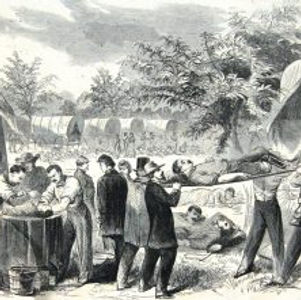THE AMERICAN CIVIL WAR AND ITS IMPACT ON MEDICAL CARE
Contact Me - 21tleatherwood@msjnet.net
 |
|---|
 |
 |
 |
 |
 |
 |
WHAT INFLUENCE DID THE CIVIL WAR HAVE ON THE DEVELOPMENT OF MEDICAL CARE?
1861-1865

JONATHAN LETTERMAN'S AMBULANCE SYSTEM
How did Letterman's system help soldiers during the war, and how did his ideas have significance in today's society?
The Civil War saw almost 1.7 million casualties, whether they were in battle, disease, (etc.). These injured soldiers found it hard to receive medical attention in the middle of a raging battle. Dr. Jonathan Letterman, the medical director of the Army of the Potomac, devised an on-site, groundbreaking system that revolutionized care of wounded soldiers.
He used a 750 lb wagon, towed by two to four horses, that could carry two to six, even eight soldiers, with room for medical supplies. As they were being transported to field hospitals, nurses would administer whichever treatment was necessary, surely saving hundreds of lives. Letterman also practiced high standards for his medical corps, with routine inspections of the wagons, supplies, and the nurses treating the soldiers. During the Battle of Antietam, using Letterman's system, every fallen or wounded soldier was transported and given medical care within a day.
Letterman's system influenced the birth of Triage, or determining the degree of urgency for medical attention (i.e, a soldier with a wound to the leg will receive attention first, rather than one with a small wound in the foot.). Doctors in field hospitals did not intelligently determine which soldiers would get attention, inevitably leading to lost lives. Letterman's principle of quick transport is used today to transport victims of strokes or heart attacks to hospitals rapidly. His practice of triage is used when responding to 911 calls today. Lastly, The National Museum of Civil War Medicine has used Letterman's ideas to train thousands of medical professionals who go overseas.
Letterman's innovative system has had long term impacts, not just on Civil War soldiers, but on everyday Americans.
FUN FACT
Clara Barton was instrumental in locating missing soldiers after the war. Through her program after the war, she located almost 22,000 soldiers thought to be missing. through 63,000 inquiries. Barton was also a pioneer in making public notices, through newspaper ads, posters in the community, and contact with the soldier's family. She also is known for being one of the first nurses to encourage civilians to donate medical supplies, like bandages, canned food, clothing, medicine, etc. The Clara Barton Missing Soldiers Office still stands today in Washington D.C.
SURGICAL OPERATIONS
How did the tools and techniques used in surgeries during the war evolve into modern day procedures?
The Civil War saw 620,000 fatalities, with 2/3 of them from Infection. 60,000 amputations were performed during the war. Infection plagued these soldiers because Doctors did not disinfect their tools. Today, we hear all about how Civil War doctors were "butchers" and hacked off limbs by the dozen. Actually, most Doctors in that period were experienced and trained.
Amputations actually saved lives; by cutting off an infected limb, the infection could not reach the rest of the body. Also, we hear that there were no anesthetics in that time, and soldiers suffered immense pain on the operating table. Wrong Again. Doctors used Chloroform, a painkiller that numbed the body just enough so that the soldier could not feel anything. Bromine was also a major treatment, used to fight gangrene, a dangerous killer. The Civil War also saw the first soldiers in American History to receive prosthetic limbs. The Civil War was also the starting point for the development of medical instruments, like forceps, stethoscopes, tourniquets, and amputation saws. Forceps were used to extract bullets lodged in a soldiers's body.
At that time, doctors used a small wooden plank to listen to a heartbeat. It had hole at the top, where a doctor's ear would go; that eventually evolved into the modern day stethoscope. Some amputees suffered from long term health problems after the war. Crutches and wheel chairs became more familiar, and were used by many veterans after the war.
Depression, suicide, Insanity, and PTSD were all common among veterans returning home. The Civil War also saw the first veterans groups established, the Grand Army of the Republic/G.A.R (Union), and the United Confederate Veterans/U.C.V (Confederate). The U.C.V is known today as the group that pushed more memorials to be erected in the South, which are heavily debated today.
 |  |  |
|---|---|---|
 |
